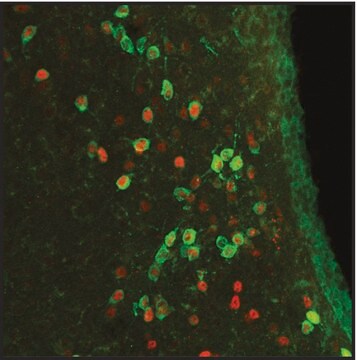Kluczowe dokumenty
A5979
Anti-ARP3 antibody, Mouse monoclonal
clone FMS338, purified from hybridoma cell culture
Synonim(y):
ARP3 Detection Antibody, Mouse Anti-ARP3
About This Item
Polecane produkty
pochodzenie biologiczne
mouse
Poziom jakości
białko sprzężone
unconjugated
forma przeciwciała
purified immunoglobulin
rodzaj przeciwciała
primary antibodies
klon
FMS338, monoclonal
Formularz
buffered aqueous solution
masa cząsteczkowa
antigen 40-45 kDa
reaktywność gatunkowa
human, mouse, rat, canine
opakowanie
antibody small pack of 25 μL
metody
immunocytochemistry: suitable
indirect ELISA: suitable
microarray: suitable
western blot: 0.25-0.5 μg/mL using total cell extract of mouse myoblast C2 cells
izotyp
IgG2b
numer dostępu UniProt
Warunki transportu
dry ice
temp. przechowywania
−20°C
docelowa modyfikacja potranslacyjna
unmodified
informacje o genach
human ... ACTR3(10096)
mouse ... Actr3(74117)
rat ... Actr3(81732)
Opis ogólny
Immunogen
Zastosowanie
- enzyme linked immunosorbent assay (ELISA)
- immunocytochemistry
- immunoblotting
- immunoprecipitation
- immunofluorescence
- immunohistochemistry
Działania biochem./fizjol.
Postać fizyczna
Oświadczenie o zrzeczeniu się odpowiedzialności
Nie możesz znaleźć właściwego produktu?
Wypróbuj nasz Narzędzie selektora produktów.
Kod klasy składowania
10 - Combustible liquids
Klasa zagrożenia wodnego (WGK)
WGK 2
Temperatura zapłonu (°F)
Not applicable
Temperatura zapłonu (°C)
Not applicable
Wybierz jedną z najnowszych wersji:
Masz już ten produkt?
Dokumenty związane z niedawno zakupionymi produktami zostały zamieszczone w Bibliotece dokumentów.
Nasz zespół naukowców ma doświadczenie we wszystkich obszarach badań, w tym w naukach przyrodniczych, materiałoznawstwie, syntezie chemicznej, chromatografii, analityce i wielu innych dziedzinach.
Skontaktuj się z zespołem ds. pomocy technicznej






